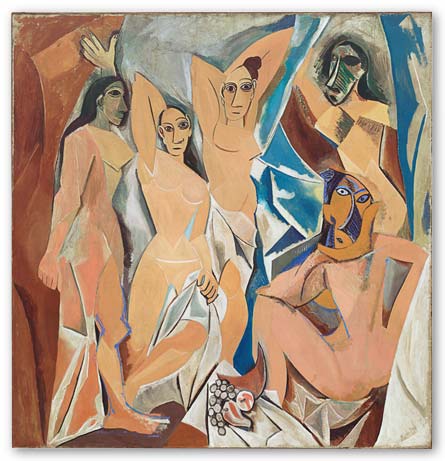Before meeting Picasso, Georges Braque was invested primarily in Fauvism, which was a style that Henri Matisse worked in that utilized bright colors and loosely defined forms (similar to Impressionism) to achieve an emotional response (similar to Expressionism).
 | ||||
| The Great Trees, L'Estaque (1906-07) by Georges Braque, oil on canvas, 31.5", 27.75". |
 | |
| Luxe, Calme et Volupte by Henri Matisse (1904-05). |
 |
| Pablo Picasso, Three Women, 1907-1908, Oil on Canvas, 6' 6.75" * 7' 6.5" |
 | |
| Pablo Picasso, Les Demoiselles d'Avignon, 1907, Oil on Canvas, 8' * 7' 8". |
As can be seen, both works feature nude women, but when Cubism is applied, the women's bodies and the backgrounds of both works are fragmented into shapes that aren't always perfectly symmetrical, as one might expect from an academic work. It was this lack of symmetry as well as foreshortening that challenged the viewer to look more carefully at the space within the works. The inspiration for these two paintings stemmed primarily from Picasso's inspiration from some imported African masks that he got a hold of, and his experiences in a brothel, which he decided to convert into these works.
 |
| This mask, from West Africa, is considered by many to be the inspiration for Les Demoiselles d'Avignon. |
Taking inspiration from Picasso, Braque also began dabbling in Cubism as well, bringing in the theme of musical instruments in 1909 when he went to Paris for the winter.
 |
| Georges Braque, Violin and Palette, 1909, Oil on Canvas, 36.125", 16.875" |
Cubism would continue on to pave the way for Dada and Surrealism.
Sources:
http://www.vanityfair.com/online/daily/2011/10/georges-braque--from-fauvism-to-cubism#slide=1
http://www.georgesbraque.org/
http://www.henri-matisse.net/artofmatisse.html
http://www.metmuseum.org/toah/hd/cube/hd_cube.htm
http://www.hermitagemuseum.org/html_En/03/hm3_3_1_8c.html
http://www.moma.org/explore/conservation/demoiselles/history.html
No comments:
Post a Comment